Effective Communication Strategies in Doctor-Patient Care
VerifiedAdded on 2023/06/10
|7
|1406
|169
Report
AI Summary
This report explores the dynamics of doctor-patient communication, highlighting the inherent power imbalance and the evolution of communication methods within the healthcare system. It discusses the role of technology, such as electronic health records and mobile health applications, in facilitating communication and addressing issues like long wait times and limited doctor availability. The report also emphasizes the manager's role in providing technological resources and addressing miscommunication, citing examples like the 'Moms on-call' project and 'SMS Mom' service. Furthermore, it addresses the importance of culturally sensitive communication in hospice settings, outlining steps for managers to improve communication processes, including research, objective setting, strategic planning, creative visual aids, and outcome evaluation. The report concludes by referencing several studies that are crucial for understanding the communication dynamics in the healthcare environment. Desklib offers similar solved assignments and study materials for students.
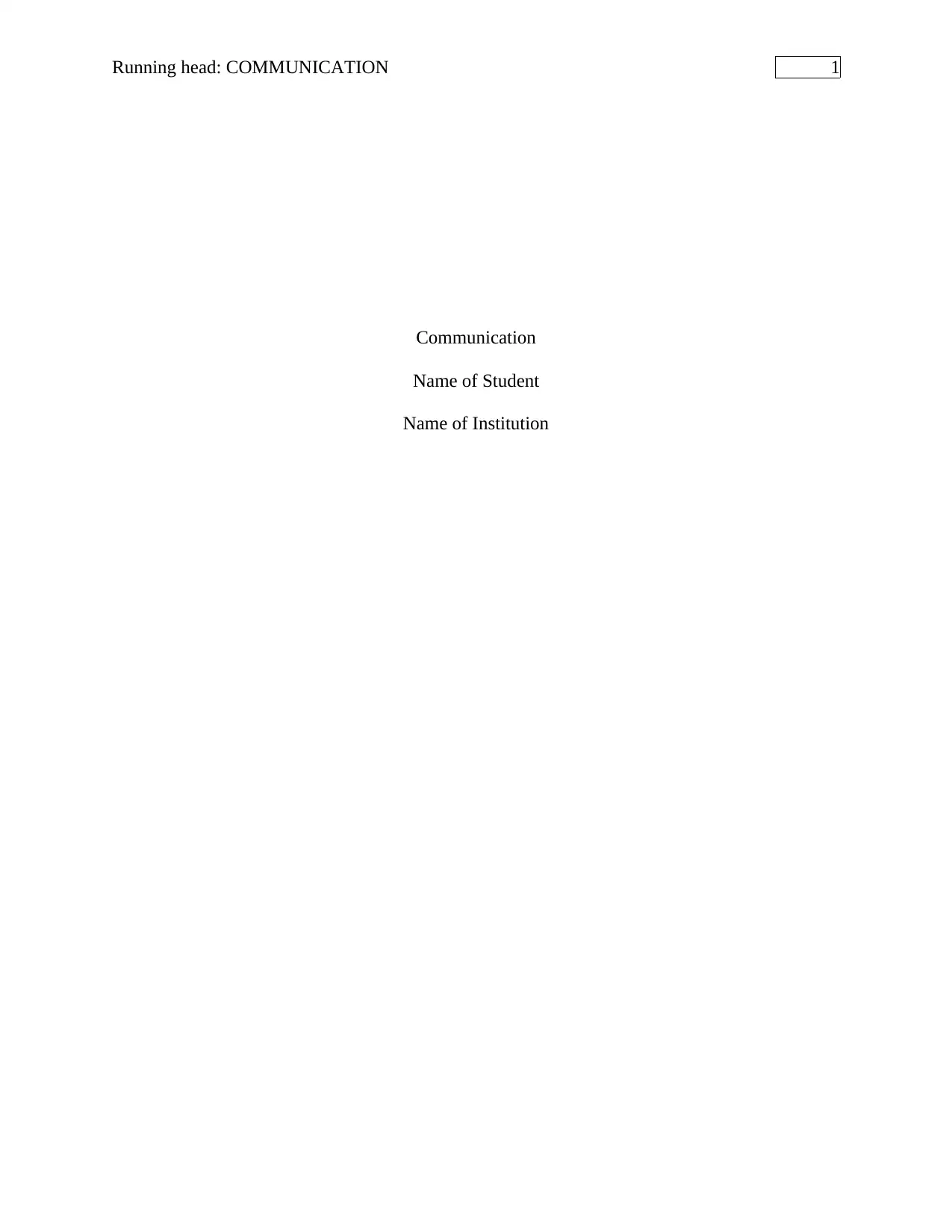
Running head: COMMUNICATION
Communication
Name of Student
Name of Institution
1
Communication
Name of Student
Name of Institution
1
Paraphrase This Document
Need a fresh take? Get an instant paraphrase of this document with our AI Paraphraser
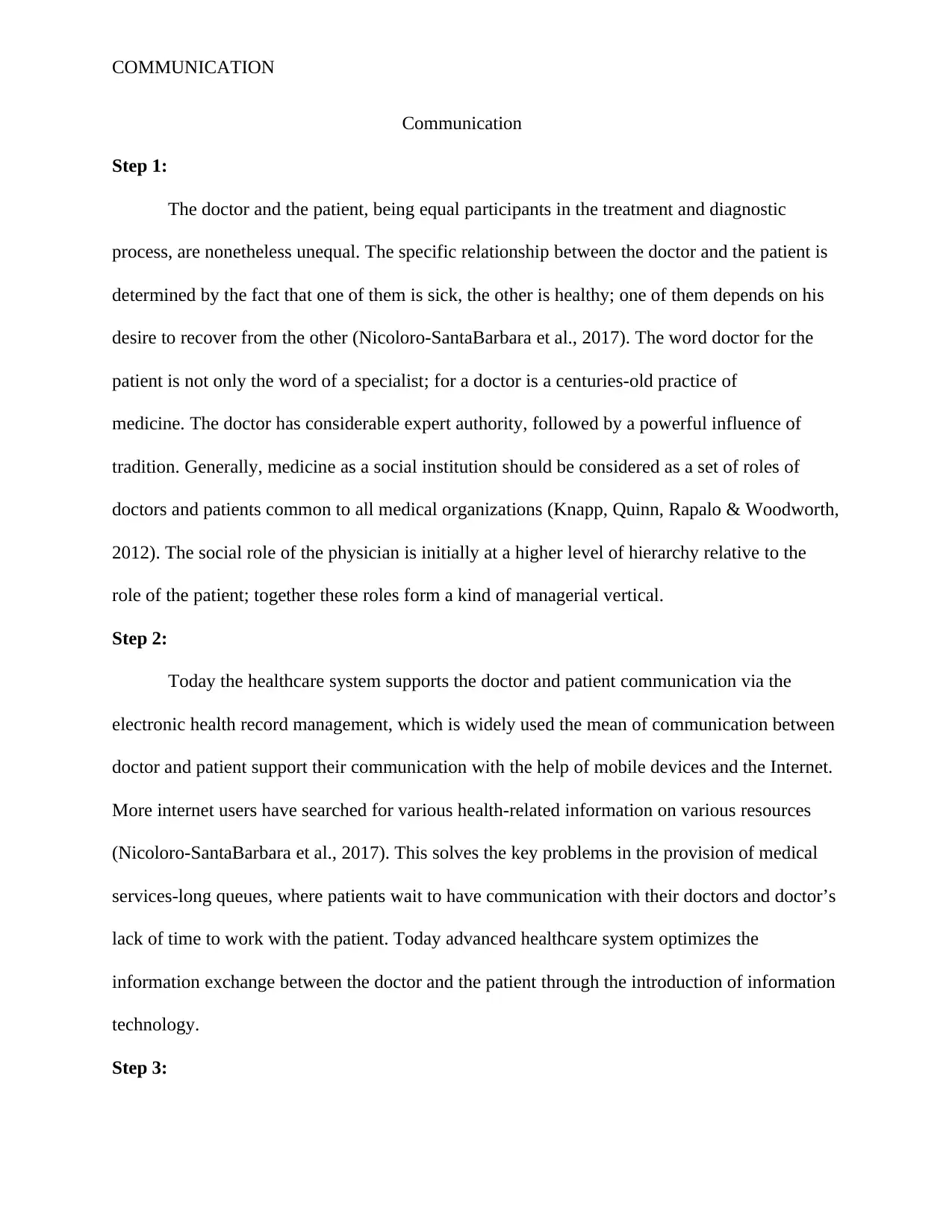
COMMUNICATION
Communication
Step 1:
The doctor and the patient, being equal participants in the treatment and diagnostic
process, are nonetheless unequal. The specific relationship between the doctor and the patient is
determined by the fact that one of them is sick, the other is healthy; one of them depends on his
desire to recover from the other (Nicoloro-SantaBarbara et al., 2017). The word doctor for the
patient is not only the word of a specialist; for a doctor is a centuries-old practice of
medicine. The doctor has considerable expert authority, followed by a powerful influence of
tradition. Generally, medicine as a social institution should be considered as a set of roles of
doctors and patients common to all medical organizations (Knapp, Quinn, Rapalo & Woodworth,
2012). The social role of the physician is initially at a higher level of hierarchy relative to the
role of the patient; together these roles form a kind of managerial vertical.
Step 2:
Today the healthcare system supports the doctor and patient communication via the
electronic health record management, which is widely used the mean of communication between
doctor and patient support their communication with the help of mobile devices and the Internet.
More internet users have searched for various health-related information on various resources
(Nicoloro-SantaBarbara et al., 2017). This solves the key problems in the provision of medical
services-long queues, where patients wait to have communication with their doctors and doctor’s
lack of time to work with the patient. Today advanced healthcare system optimizes the
information exchange between the doctor and the patient through the introduction of information
technology.
Step 3:
Communication
Step 1:
The doctor and the patient, being equal participants in the treatment and diagnostic
process, are nonetheless unequal. The specific relationship between the doctor and the patient is
determined by the fact that one of them is sick, the other is healthy; one of them depends on his
desire to recover from the other (Nicoloro-SantaBarbara et al., 2017). The word doctor for the
patient is not only the word of a specialist; for a doctor is a centuries-old practice of
medicine. The doctor has considerable expert authority, followed by a powerful influence of
tradition. Generally, medicine as a social institution should be considered as a set of roles of
doctors and patients common to all medical organizations (Knapp, Quinn, Rapalo & Woodworth,
2012). The social role of the physician is initially at a higher level of hierarchy relative to the
role of the patient; together these roles form a kind of managerial vertical.
Step 2:
Today the healthcare system supports the doctor and patient communication via the
electronic health record management, which is widely used the mean of communication between
doctor and patient support their communication with the help of mobile devices and the Internet.
More internet users have searched for various health-related information on various resources
(Nicoloro-SantaBarbara et al., 2017). This solves the key problems in the provision of medical
services-long queues, where patients wait to have communication with their doctors and doctor’s
lack of time to work with the patient. Today advanced healthcare system optimizes the
information exchange between the doctor and the patient through the introduction of information
technology.
Step 3:
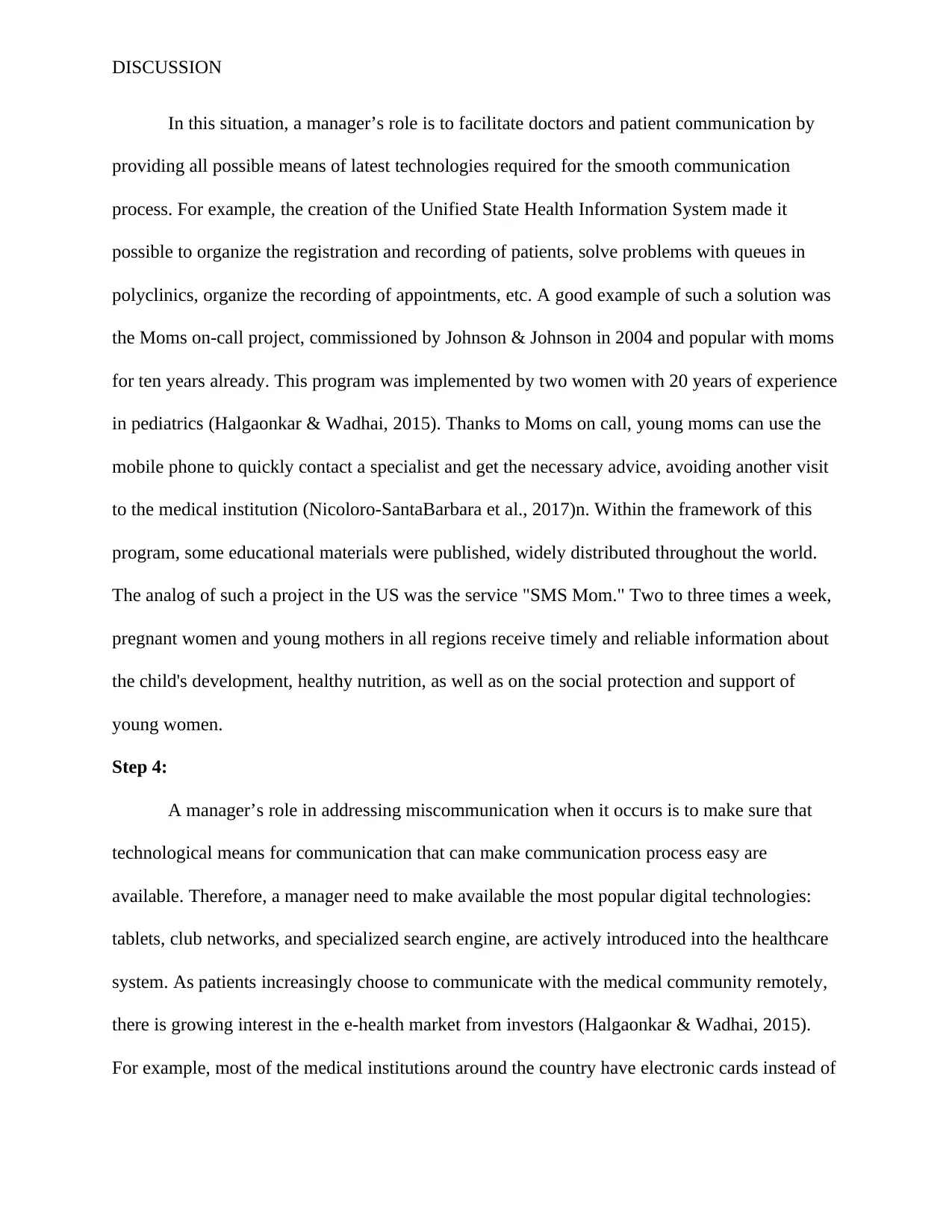
DISCUSSION
In this situation, a manager’s role is to facilitate doctors and patient communication by
providing all possible means of latest technologies required for the smooth communication
process. For example, the creation of the Unified State Health Information System made it
possible to organize the registration and recording of patients, solve problems with queues in
polyclinics, organize the recording of appointments, etc. A good example of such a solution was
the Moms on-call project, commissioned by Johnson & Johnson in 2004 and popular with moms
for ten years already. This program was implemented by two women with 20 years of experience
in pediatrics (Halgaonkar & Wadhai, 2015). Thanks to Moms on call, young moms can use the
mobile phone to quickly contact a specialist and get the necessary advice, avoiding another visit
to the medical institution (Nicoloro-SantaBarbara et al., 2017)n. Within the framework of this
program, some educational materials were published, widely distributed throughout the world.
The analog of such a project in the US was the service "SMS Mom." Two to three times a week,
pregnant women and young mothers in all regions receive timely and reliable information about
the child's development, healthy nutrition, as well as on the social protection and support of
young women.
Step 4:
A manager’s role in addressing miscommunication when it occurs is to make sure that
technological means for communication that can make communication process easy are
available. Therefore, a manager need to make available the most popular digital technologies:
tablets, club networks, and specialized search engine, are actively introduced into the healthcare
system. As patients increasingly choose to communicate with the medical community remotely,
there is growing interest in the e-health market from investors (Halgaonkar & Wadhai, 2015).
For example, most of the medical institutions around the country have electronic cards instead of
In this situation, a manager’s role is to facilitate doctors and patient communication by
providing all possible means of latest technologies required for the smooth communication
process. For example, the creation of the Unified State Health Information System made it
possible to organize the registration and recording of patients, solve problems with queues in
polyclinics, organize the recording of appointments, etc. A good example of such a solution was
the Moms on-call project, commissioned by Johnson & Johnson in 2004 and popular with moms
for ten years already. This program was implemented by two women with 20 years of experience
in pediatrics (Halgaonkar & Wadhai, 2015). Thanks to Moms on call, young moms can use the
mobile phone to quickly contact a specialist and get the necessary advice, avoiding another visit
to the medical institution (Nicoloro-SantaBarbara et al., 2017)n. Within the framework of this
program, some educational materials were published, widely distributed throughout the world.
The analog of such a project in the US was the service "SMS Mom." Two to three times a week,
pregnant women and young mothers in all regions receive timely and reliable information about
the child's development, healthy nutrition, as well as on the social protection and support of
young women.
Step 4:
A manager’s role in addressing miscommunication when it occurs is to make sure that
technological means for communication that can make communication process easy are
available. Therefore, a manager need to make available the most popular digital technologies:
tablets, club networks, and specialized search engine, are actively introduced into the healthcare
system. As patients increasingly choose to communicate with the medical community remotely,
there is growing interest in the e-health market from investors (Halgaonkar & Wadhai, 2015).
For example, most of the medical institutions around the country have electronic cards instead of
⊘ This is a preview!⊘
Do you want full access?
Subscribe today to unlock all pages.

Trusted by 1+ million students worldwide
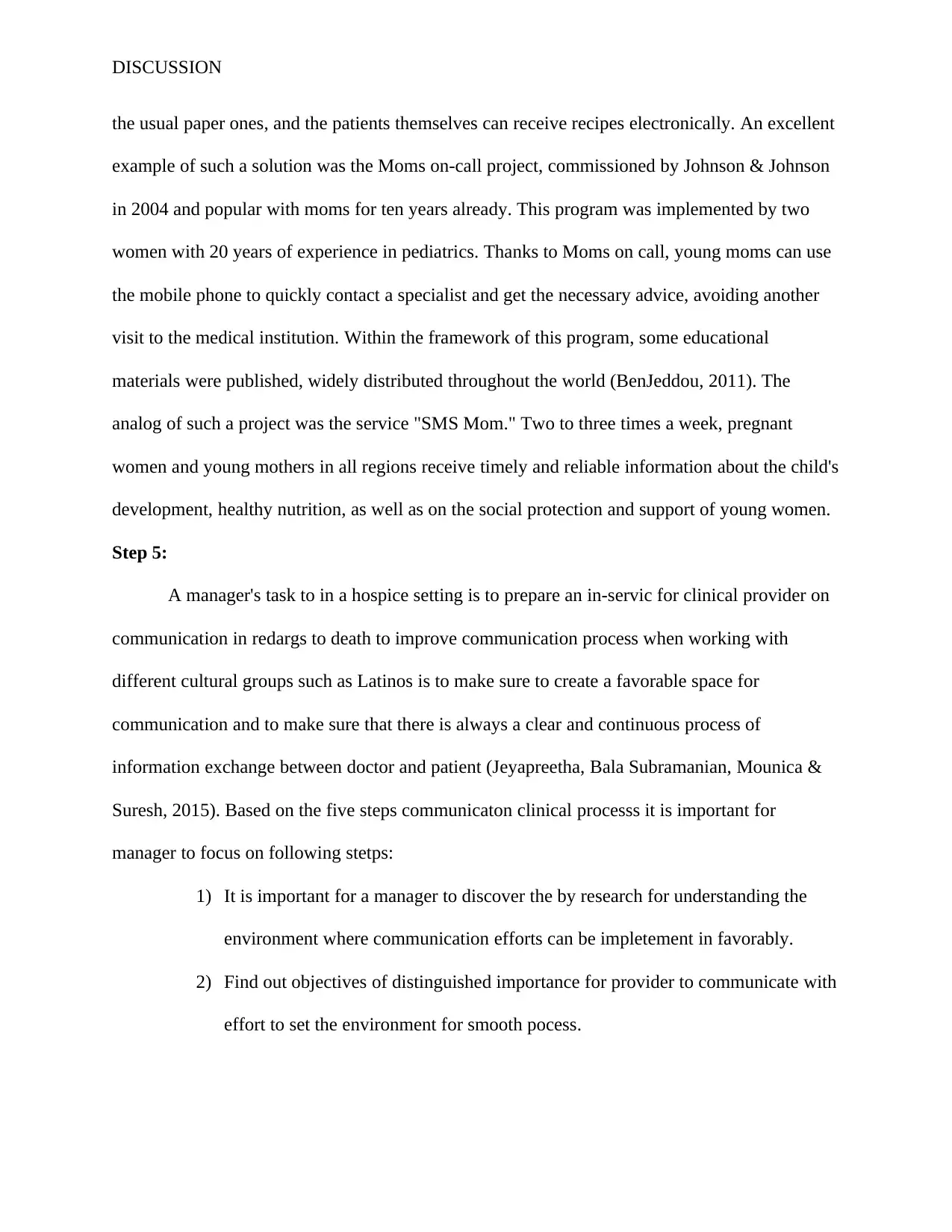
DISCUSSION
the usual paper ones, and the patients themselves can receive recipes electronically. An excellent
example of such a solution was the Moms on-call project, commissioned by Johnson & Johnson
in 2004 and popular with moms for ten years already. This program was implemented by two
women with 20 years of experience in pediatrics. Thanks to Moms on call, young moms can use
the mobile phone to quickly contact a specialist and get the necessary advice, avoiding another
visit to the medical institution. Within the framework of this program, some educational
materials were published, widely distributed throughout the world (BenJeddou, 2011). The
analog of such a project was the service "SMS Mom." Two to three times a week, pregnant
women and young mothers in all regions receive timely and reliable information about the child's
development, healthy nutrition, as well as on the social protection and support of young women.
Step 5:
A manager's task to in a hospice setting is to prepare an in-servic for clinical provider on
communication in redargs to death to improve communication process when working with
different cultural groups such as Latinos is to make sure to create a favorable space for
communication and to make sure that there is always a clear and continuous process of
information exchange between doctor and patient (Jeyapreetha, Bala Subramanian, Mounica &
Suresh, 2015). Based on the five steps communicaton clinical processs it is important for
manager to focus on following stetps:
1) It is important for a manager to discover the by research for understanding the
environment where communication efforts can be impletement in favorably.
2) Find out objectives of distinguished importance for provider to communicate with
effort to set the environment for smooth pocess.
the usual paper ones, and the patients themselves can receive recipes electronically. An excellent
example of such a solution was the Moms on-call project, commissioned by Johnson & Johnson
in 2004 and popular with moms for ten years already. This program was implemented by two
women with 20 years of experience in pediatrics. Thanks to Moms on call, young moms can use
the mobile phone to quickly contact a specialist and get the necessary advice, avoiding another
visit to the medical institution. Within the framework of this program, some educational
materials were published, widely distributed throughout the world (BenJeddou, 2011). The
analog of such a project was the service "SMS Mom." Two to three times a week, pregnant
women and young mothers in all regions receive timely and reliable information about the child's
development, healthy nutrition, as well as on the social protection and support of young women.
Step 5:
A manager's task to in a hospice setting is to prepare an in-servic for clinical provider on
communication in redargs to death to improve communication process when working with
different cultural groups such as Latinos is to make sure to create a favorable space for
communication and to make sure that there is always a clear and continuous process of
information exchange between doctor and patient (Jeyapreetha, Bala Subramanian, Mounica &
Suresh, 2015). Based on the five steps communicaton clinical processs it is important for
manager to focus on following stetps:
1) It is important for a manager to discover the by research for understanding the
environment where communication efforts can be impletement in favorably.
2) Find out objectives of distinguished importance for provider to communicate with
effort to set the environment for smooth pocess.
Paraphrase This Document
Need a fresh take? Get an instant paraphrase of this document with our AI Paraphraser
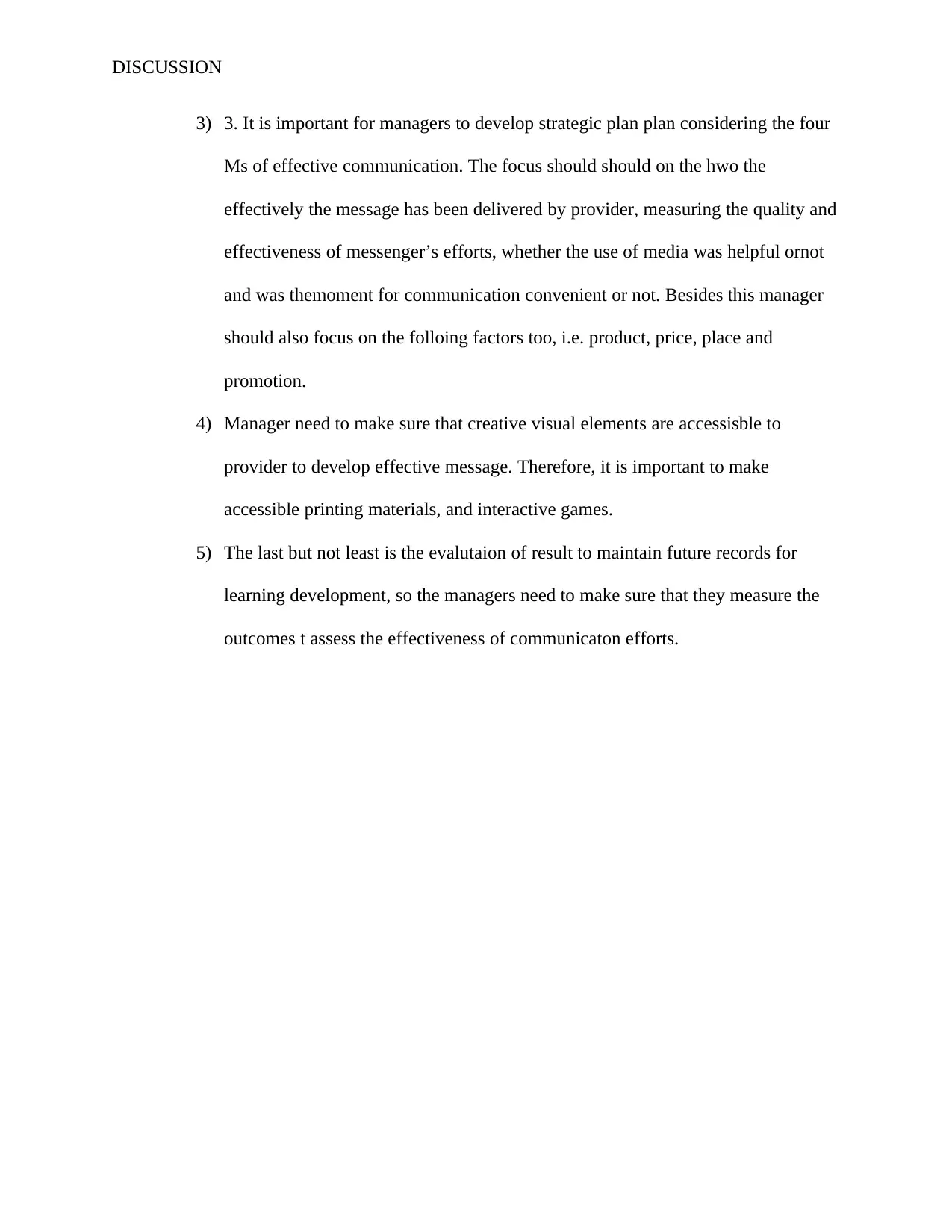
DISCUSSION
3) 3. It is important for managers to develop strategic plan plan considering the four
Ms of effective communication. The focus should should on the hwo the
effectively the message has been delivered by provider, measuring the quality and
effectiveness of messenger’s efforts, whether the use of media was helpful ornot
and was themoment for communication convenient or not. Besides this manager
should also focus on the folloing factors too, i.e. product, price, place and
promotion.
4) Manager need to make sure that creative visual elements are accessisble to
provider to develop effective message. Therefore, it is important to make
accessible printing materials, and interactive games.
5) The last but not least is the evalutaion of result to maintain future records for
learning development, so the managers need to make sure that they measure the
outcomes t assess the effectiveness of communicaton efforts.
3) 3. It is important for managers to develop strategic plan plan considering the four
Ms of effective communication. The focus should should on the hwo the
effectively the message has been delivered by provider, measuring the quality and
effectiveness of messenger’s efforts, whether the use of media was helpful ornot
and was themoment for communication convenient or not. Besides this manager
should also focus on the folloing factors too, i.e. product, price, place and
promotion.
4) Manager need to make sure that creative visual elements are accessisble to
provider to develop effective message. Therefore, it is important to make
accessible printing materials, and interactive games.
5) The last but not least is the evalutaion of result to maintain future records for
learning development, so the managers need to make sure that they measure the
outcomes t assess the effectiveness of communicaton efforts.
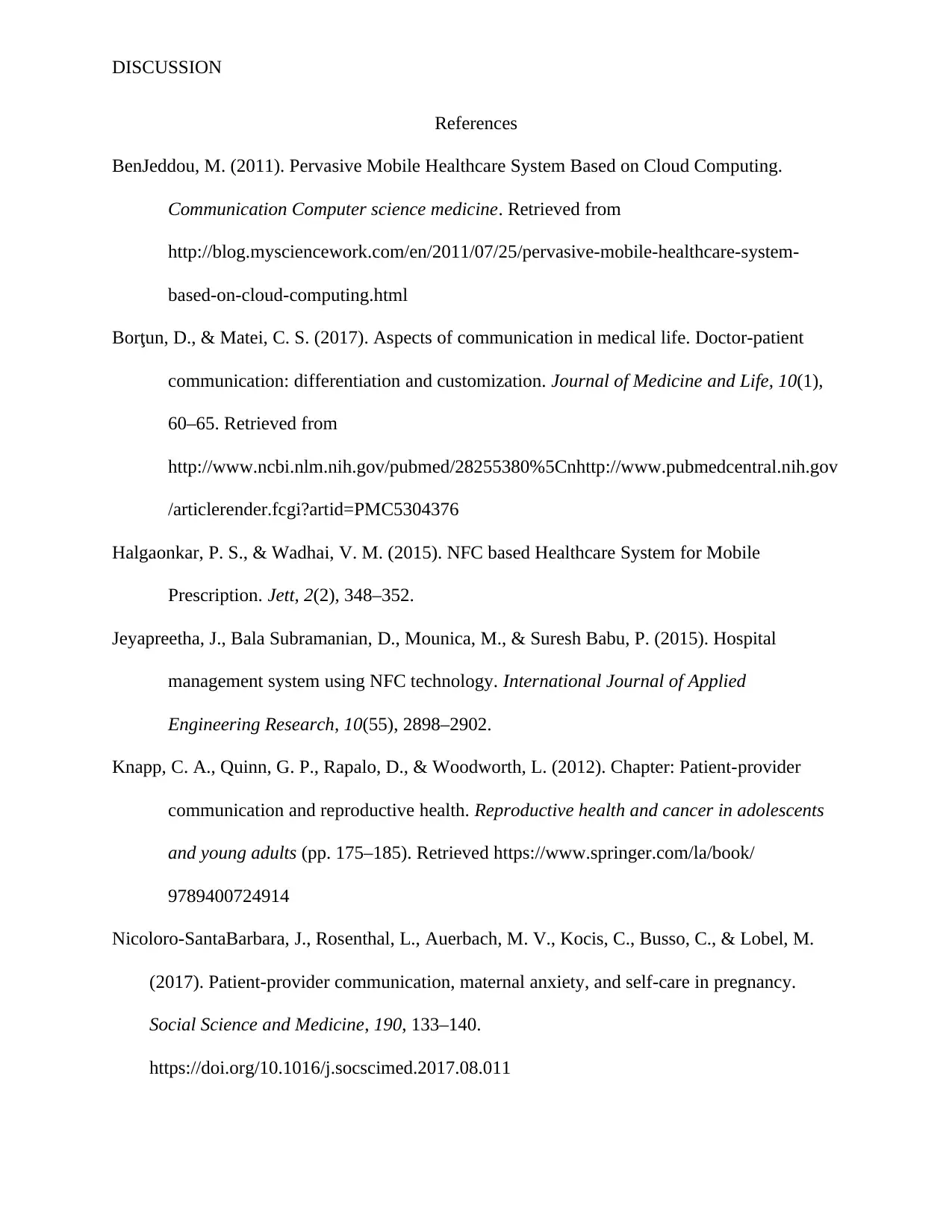
DISCUSSION
References
BenJeddou, M. (2011). Pervasive Mobile Healthcare System Based on Cloud Computing.
Communication Computer science medicine. Retrieved from
http://blog.mysciencework.com/en/2011/07/25/pervasive-mobile-healthcare-system-
based-on-cloud-computing.html
Borţun, D., & Matei, C. S. (2017). Aspects of communication in medical life. Doctor-patient
communication: differentiation and customization. Journal of Medicine and Life, 10(1),
60–65. Retrieved from
http://www.ncbi.nlm.nih.gov/pubmed/28255380%5Cnhttp://www.pubmedcentral.nih.gov
/articlerender.fcgi?artid=PMC5304376
Halgaonkar, P. S., & Wadhai, V. M. (2015). NFC based Healthcare System for Mobile
Prescription. Jett, 2(2), 348–352.
Jeyapreetha, J., Bala Subramanian, D., Mounica, M., & Suresh Babu, P. (2015). Hospital
management system using NFC technology. International Journal of Applied
Engineering Research, 10(55), 2898–2902.
Knapp, C. A., Quinn, G. P., Rapalo, D., & Woodworth, L. (2012). Chapter: Patient-provider
communication and reproductive health. Reproductive health and cancer in adolescents
and young adults (pp. 175–185). Retrieved https://www.springer.com/la/book/
9789400724914
Nicoloro-SantaBarbara, J., Rosenthal, L., Auerbach, M. V., Kocis, C., Busso, C., & Lobel, M.
(2017). Patient-provider communication, maternal anxiety, and self-care in pregnancy.
Social Science and Medicine, 190, 133–140.
https://doi.org/10.1016/j.socscimed.2017.08.011
References
BenJeddou, M. (2011). Pervasive Mobile Healthcare System Based on Cloud Computing.
Communication Computer science medicine. Retrieved from
http://blog.mysciencework.com/en/2011/07/25/pervasive-mobile-healthcare-system-
based-on-cloud-computing.html
Borţun, D., & Matei, C. S. (2017). Aspects of communication in medical life. Doctor-patient
communication: differentiation and customization. Journal of Medicine and Life, 10(1),
60–65. Retrieved from
http://www.ncbi.nlm.nih.gov/pubmed/28255380%5Cnhttp://www.pubmedcentral.nih.gov
/articlerender.fcgi?artid=PMC5304376
Halgaonkar, P. S., & Wadhai, V. M. (2015). NFC based Healthcare System for Mobile
Prescription. Jett, 2(2), 348–352.
Jeyapreetha, J., Bala Subramanian, D., Mounica, M., & Suresh Babu, P. (2015). Hospital
management system using NFC technology. International Journal of Applied
Engineering Research, 10(55), 2898–2902.
Knapp, C. A., Quinn, G. P., Rapalo, D., & Woodworth, L. (2012). Chapter: Patient-provider
communication and reproductive health. Reproductive health and cancer in adolescents
and young adults (pp. 175–185). Retrieved https://www.springer.com/la/book/
9789400724914
Nicoloro-SantaBarbara, J., Rosenthal, L., Auerbach, M. V., Kocis, C., Busso, C., & Lobel, M.
(2017). Patient-provider communication, maternal anxiety, and self-care in pregnancy.
Social Science and Medicine, 190, 133–140.
https://doi.org/10.1016/j.socscimed.2017.08.011
⊘ This is a preview!⊘
Do you want full access?
Subscribe today to unlock all pages.

Trusted by 1+ million students worldwide

DISCUSSION
1 out of 7
Related Documents
Your All-in-One AI-Powered Toolkit for Academic Success.
+13062052269
info@desklib.com
Available 24*7 on WhatsApp / Email
![[object Object]](/_next/static/media/star-bottom.7253800d.svg)
Unlock your academic potential
Copyright © 2020–2025 A2Z Services. All Rights Reserved. Developed and managed by ZUCOL.





